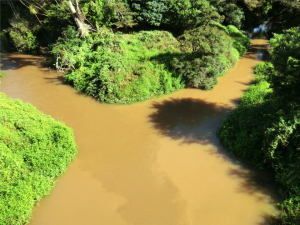19 December 2014
New Zealand watersheds show the dirt on logging and grazing
Posted by Nanci Bompey
By Nala Rogers

The Hoteo River in New Zealand is brown with suspended sediment in this photograph from 2012. Scientists are working to determine how water quality problems relate to land use.
Image Credit: Jason Julian
Grazing animals and logging trees in New Zealand could affect water quality there, according to scientists working to determine how water quality problems in the country relate to land use.
The results could help guide water-friendly policy in New Zealand and other parts of the world, according to Jason Julian, a geographer at Texas State University.
“We can relate the landscape analysis with the water quality analysis to hopefully assess what effect these land management policies are having on water quality,” said Braden Owsley, a technician at the University of Oklahoma. The team presented their research with two posters Tuesday morning at the American Geophysical Union’s fall meeting in San Francisco.
New Zealand is an ideal site to investigate the effects of land use policy because its municipal boundaries match the edges of drainage basins, according to Julian. “It gives you a great natural experiment,” said Julian.
For the first stage of the project, the team used satellite image data to measure the greenness, brightness, and wetness of forest and grassland areas from 2000 to 2013. This allowed them to see when deforestation or overgrazing stripped land of its plant cover, leaving exposed dirt to wash away and pollute rivers.
It’s important to study grasslands because of New Zealand’s grazing practices, according to Owsley. New Zealand farmers often cram large numbers of sheep or cattle into small areas, and rotate them onto fresh patches of land when the animals run out of grass. With adequate rainfall, the grass will grow back in a couple of weeks, leading some people to dismiss the environmental damage, according to Owsley. But until the grass grows back, dirt can wash away every time it rains. Julian noted that similar grazing practices are on the rise in the United States.
The researchers have matched the groundcover analysis with water quality data for one of the watersheds, and Julian hopes to finish the rest in the next year. Their results so far confirm that intensive grazing can damage water quality, and suggest that the damage is worst when drought conditions delay regrowth of grass. The team will also contrast their measurements with the regulations guiding land use in the different regions.
— Nala Rogers is a science communication graduate student at UC Santa Cruz










 GeoSpace is a blog on Earth and space science, managed by AGU’s Public Information staff. The blog features posts by AGU writers and guest contributors on all sorts of relevant science topics, but with a focus on new research and geo and space sciences-related stories that are currently in the news.
GeoSpace is a blog on Earth and space science, managed by AGU’s Public Information staff. The blog features posts by AGU writers and guest contributors on all sorts of relevant science topics, but with a focus on new research and geo and space sciences-related stories that are currently in the news.
The watershed areas near cities are mostly seeing polluted. With time, the village watersheds are also getting polluted. The garbage, waste material can be seen piled up in market /town area near the village watershed.It is important to make watershed plan in line with controlling increasing…… for more please go through
http://www.watershedpedia.com/pollution-in-village-watershed/